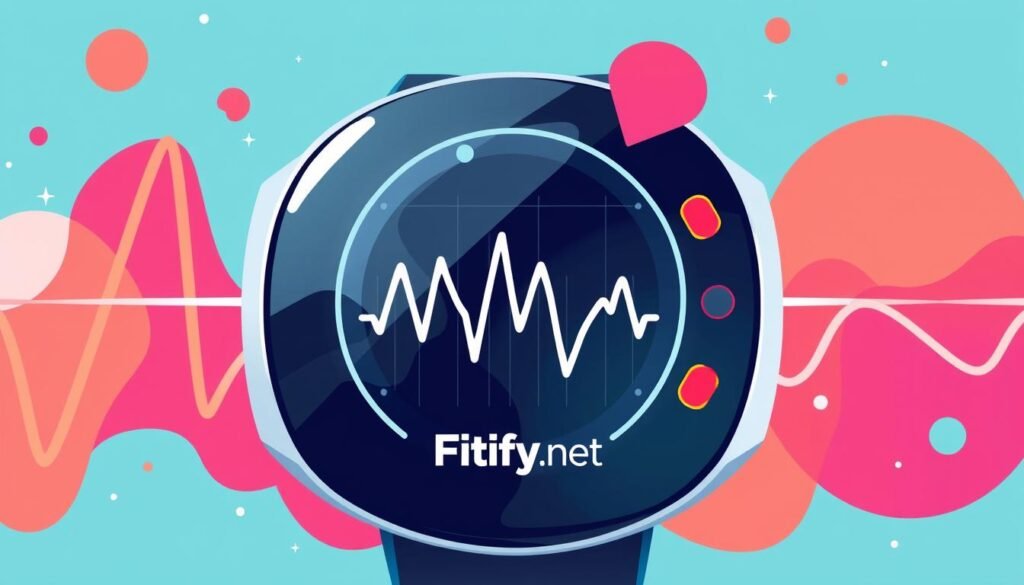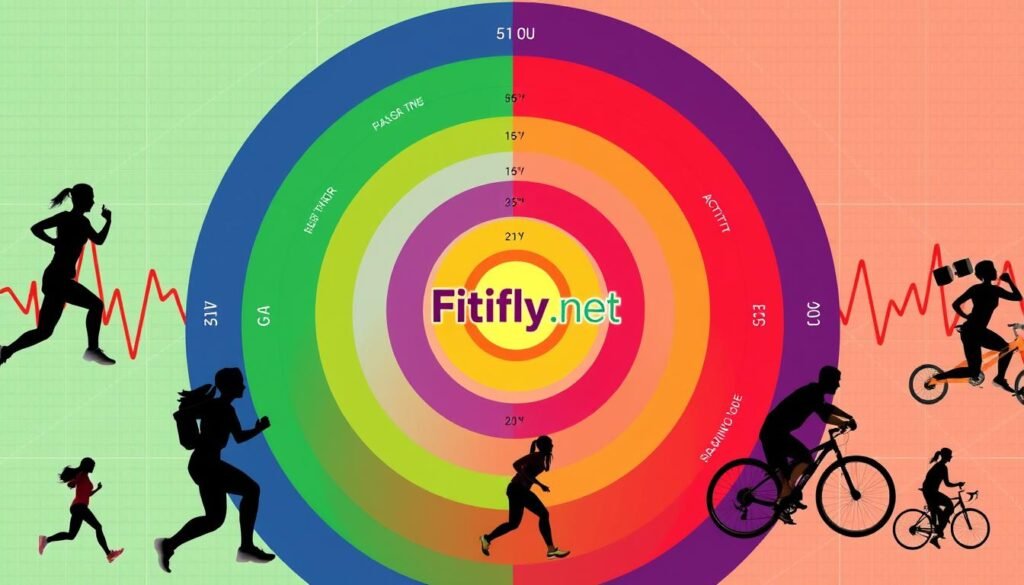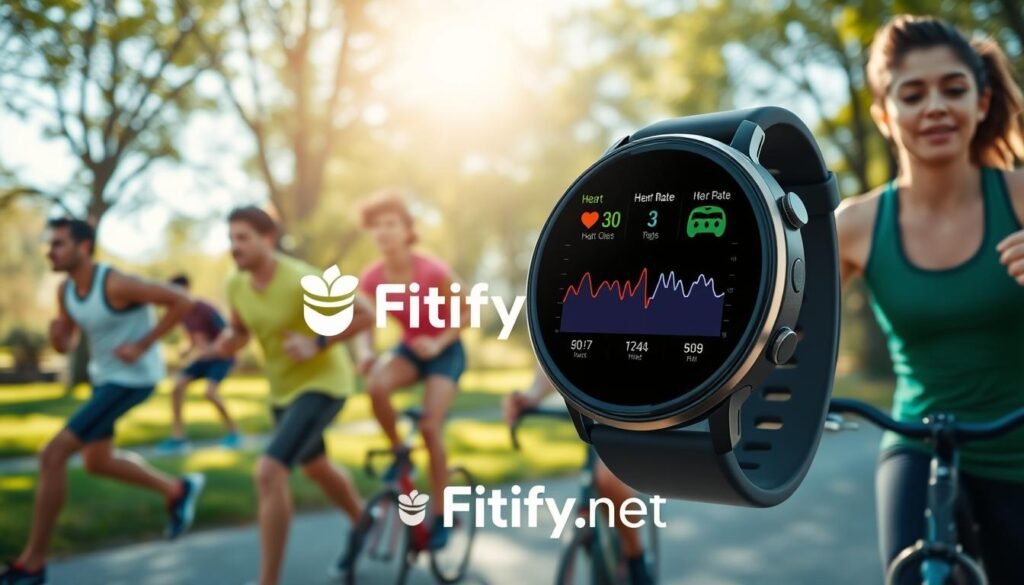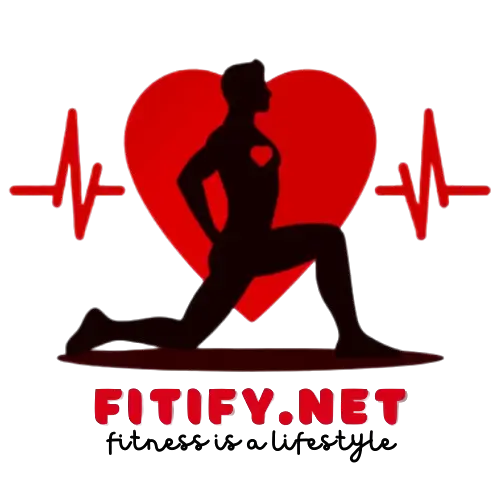Ever thought your Maximum Heart Rate (MHR) could unlock your fitness? In the world of personal training, knowing and using your MHR is key. It helps create a workout plan that fits you perfectly. But what is Maximum Heart Rate (MHR), and how does it change your fitness path?

Maximum Heart Rate (MHR) is the highest beats per minute your heart can do during hard exercise1. It’s vital for setting your heart rate training zones. These zones help you get the most out of your workouts. The science behind heart rate training is changing how we work out, from Orangetheory Fitness to the American Heart Association.
Key Takeaways
- Maximum Heart Rate (MHR) is the highest number of times your heart can beat per minute during intense exercise.
- 1 Orangetheory Fitness uses a custom algorithm to adjust MaxHR after 5 eligible classes in 120 days, ensuring accurate heart rate zone monitoring.
- 2 The American Heart Association suggests targeting 50-70% of MaxHR for moderate exercise and 70-85% for vigorous exercise.
- Personalized heart rate zones are key for making effective, safe, and fun fitness plans.
- Tracking your heart rate during workouts can help you optimize your training and reach your fitness goals.
Understanding Max Heart Rate and Its Importance
Maximum Heart Rate (MHR), or max heart rate, is key in fitness planning and heart rate training. It shows the highest heart rate during hard exercise3. Knowing your max heart rate helps set the right exercise intensity, personal fitness goals, and improves heart health3.
Definition of Maximum Heart Rate (MHR)
Your Max Heart Rate (MHR) is found by subtracting your age from 2203. For example, if you’re 50, your max heart rate is about 170 beats per minute3. This is a basic estimate. There are more precise ways to find your max heart rate, as we’ll see later4.
Role in Fitness Planning
Your Max Heart Rate (MHR) helps set your target heart rate zones during exercise3. These zones, based on your MHR, help you work out at the right intensity for your goals3. Devices can often find these zones for you, making it easier3.
Benefits of Heart Rate-Based Training
Using your max heart rate for workouts has many benefits. It helps improve your heart health, burn calories, and boost your performance3. It also keeps you motivated by letting you know when to push harder and track your progress3.
By using your max heart rate in your workouts, you can get the most out of heart rate training. This helps you reach your health and fitness goals more efficiently and accurately345.
| Heart Rate Zone | Percentage of Max Heart Rate | Intensity Level |
|---|---|---|
| Low Intensity | 40-50% | Light |
| Moderate Intensity | 50-60% | Moderate |
| High Intensity | 60-70% | High |
| Maximum Intensity | 85-100% | Maximal |
The target heart rate is usually between 50 percent and 85 percent of your max heart rate3. Resting heart rates vary, with very fit people having rates as low as 40 to 50 beats per minute3. It’s important to listen to your body’s signs, like breathing and sweating, to adjust your workout intensity3.
“Monitoring heart rate during workouts can be highly motivating for individuals to achieve their desired level of exertion and fitness goals.”
Knowing your max heart rate is key for safe and effective workouts. It helps you set the right intensity to reach your fitness goals without risking injury45.
The Science Behind Heart Rate Training Zones
Understanding heart rate training zones is key to a better workout. These zones are based on your Maximum Heart Rate (MHR). You can find this using the age-adjusted formula or the Karvonen formula, which also considers your resting heart rate67.
Heart rate zones range from Zone 1 (50-60% of max HR) to Zone 5 (92-100% of max HR). Each zone has a different exercise intensity and how your body responds7. Zone 1 burns the most fat, while Zone 5 burns almost none.
To find your target heart rate for each zone, you need to know your heart rate reserve. This is the difference between your maximum and resting heart rates. Knowing this helps you tailor your workouts to meet your fitness goals, like losing weight or improving endurance7.
| Heart Rate Zone | Percentage of Max HR | Calorie Burn Breakdown |
|---|---|---|
| Zone 1 | 50-60% | 85% fat, 15% carbohydrate |
| Zone 2 | 61-70% | 65% fat, 35% carbohydrate |
| Zone 3 | 71-83% | 45% fat, 55% carbohydrate |
| Zone 4 | 84-91% | Negligible fat burn, 95% carbohydrate |
| Zone 5 | 92-100% | Minimal fat burn, 100% carbohydrate |
The American Heart Association says you should do at least 150 minutes of moderate-intensity aerobic activity (zones 1 to 3) a week. Or, do 75 minutes of vigorous aerobic activity (zones 3 to 4) for better health in less time7.
By using heart rate training zones in your workouts, you can make your exercise more effective. This helps you reach your fitness goals, whether it’s losing weight, getting better endurance, or improving your heart health67.
Max Heart Rate by Age: Complete Calculation Guide
Knowing your Maximum Heart Rate (MHR) is key for a good fitness plan. The old rule “220 minus age” is common but might be off by 40 beats for seniors8. New methods, like “211 – 0.64*age” from the HUNT Fitness Study, give a better guess8.
Modern Calculation Methods
The HUNT Fitness Study looked at 3,320 healthy adults to create this new formula8. But, people on beta blockers will see their max heart rate drop because of the drug8. Also, genetics affect heart rate more than how fit you are8.
Accuracy Considerations
These new methods are better, but testing yourself is the best way to know your HRmax8. Tests in labs or outdoors can give you a precise number, considering your age, fitness, and where you are8. Knowing your exact HRmax helps you tailor your workouts, like using the 4×4 interval training8.
| Calculation Method | Formula | Considerations |
|---|---|---|
| Traditional Formula | 220 – Age | Can underestimate HRmax by up to 40 bpm in seniors8 |
| HUNT Fitness Study | 211 – 0.64 * Age | Derived from accurate HRmax measurements in 3,320 adults8 |
| Personalized Testing | Laboratory or Field Tests | Accounts for individual factors like fitness level and genetics8 |
By understanding how to calculate HRmax and using tests tailored to you, you can make your fitness plan better. This way, you can reach your bpm for weight loss, fitness heart rate zones, and heart rate for fat loss goals more effectively8910.
Target Heart Rate Zones for Different Fitness Goals
Understanding the different heart rate zones is key to a good workout plan11. These zones are based on your Maximum Heart Rate (MHR). They help you reach specific fitness goals and make your workouts more effective12.
The fat burn zone is between 50-69% of your Max Heart Rate. It’s great for endurance and burning fat12. The cardio zone, from 70-84% of your max, boosts your heart health and fitness12. The peak zone, 85-100% of your max, increases performance and anaerobic capacity12.
| Heart Rate Zone | Percentage of Maximum Heart Rate | Fitness Objectives |
|---|---|---|
| Fat Burn Zone | 50-69% | Endurance, Fat Metabolism |
| Cardio Zone | 70-84% | Cardiovascular Fitness |
| Peak Zone | 85-100% | Performance, Anaerobic Capacity |
Customizing your heart rate zones for your goals and fitness level makes workouts more effective12. This approach ensures safe and effective workouts. It helps you reach your fitness goals11.
“Tailoring your heart rate training plan to your specific fitness objectives is the key to unlocking your full potentia and achieving sustainable results.”
Determining Your Personal Max Heart Rate Through Testing
Finding your exact Maximum Heart Rate (MHR) can change your fitness game. While age-based formulas like 220 – your age13 are common, they might not be right for everyone13. Your actual max HR can be affected by your age, fitness, stress, and even medication13.
Laboratory Testing Methods
For the most accurate max HR, get tested by a cardiologist or exercise physiologist. They’ll use a maximal stress test on a treadmill or bike. Your heart rate is tracked as you work harder until you can’t go anymore13.
Field Testing Protocols
Field tests offer a practical way to find your max HR. You’ll increase the intensity of your workout, like running or intervals, until you can’t do more13. Make sure to warm up well and watch for any bad reactions during the test14.
Safe Testing Guidelines
It’s key to follow safety rules when testing your max HR. Always talk to a doctor before testing, if you’re over 40 or have health issues14. Also, warm up, increase intensity slowly, and keep an eye on your heart rate for a safe and accurate test13.
By finding your personal max HR through professional or field tests, you can make your workouts better. This way, you can improve your performance and health based on your body’s needs13.
Using Technology to Track Heart Rate Zones
Modern fitness devices like Fitbit and Garmin track your heart rate during workouts15. They use optical sensors or chest straps for this purpose15. You can set heart rate zones based on your Max Heart Rate or use preset zones for different goals16.
Some devices, like Fitbit, adjust heart rate zones based on your profile and workout data15. This ensures you’re training at the right intensity for your goals16. Whether it’s endurance, health, or fat loss, you’re on the right track16.
Modern wearables offer insights into your workout and recovery16. They track heart rate in real-time and provide metrics like HRV and VO2 max16. This gives you a full picture of your fitness and progress16.
Heart rate zone training can change your workout game, whether you’re an athlete or enthusiast16. By training in your personalized zones, you hit the right intensity for your goals16. Fitness trackers empower you to control your workouts and improve performance17.
| Heart Rate Zone | Intensity Level | Benefits | Myzone Effort Points (MEPs) |
|---|---|---|---|
| Zone 1 (Grey) | 50-59% of Max HR | Active recovery | 1 MEP/minute |
| Zone 2 (Blue) | 60-69% of Max HR | Endurance building | 2 MEPs/minute |
| Zone 3 (Green) | 70-79% of Max HR | Stamina improvement | 3 MEPs/minute |
| Zone 4 (Yellow) | 80-89% of Max HR | High-intensity training | 4 MEPs/minute |
| Zone 5 (Red) | 90-100% of Max HR | Maximum effort | 4 MEPs/minute |
Knowing your heart rate zones helps you create workout plans tailored to your goals17. This data-driven approach makes your workouts smarter and keeps you motivated17.
Optimizing Workouts with Heart Rate Data
Heart rate data can change your fitness journey. It helps you understand your workout intensity and follow personalized cardio fitness guidelines. This way, you can perform better and reach your goals faster.
Zone-Based Training Programs
Zone-based training uses heart rate data to set workout intensity. By working in specific heart rate zones, you target different benefits. For example, 80% of endurance workouts in the aerobic zone (60-70% of max heart rate) build a strong aerobic base and burn fat18.
The other 20% can be in higher zones to boost speed and power.
Recovery Monitoring
Good recovery is key for progress. Heart rate variability tracking shows how your body reacts to training and helps avoid overtraining19. It lets you see your nervous system’s state, helping you plan better rest and recovery.
Performance Tracking
Tracking heart rate during workouts shows how your cardio fitness improves over time19. By comparing heart rates at different intensities, you see how your body adapts. This data helps you adjust your training for better results.
Tools like Fitbit and Garmin help you see your heart rate data and track progress towards fitness goals18. Using these tools gives you insights and helps make your workouts more effective.
“Monitoring heart rate during exercise can provide valuable insights into workout intensity and endurance capacity, optimizing training efforts.”19
Common Mistakes in Heart Rate Training
Even experienced athletes can make mistakes in heart rate training. One big error is relying only on estimated Maximum Heart Rate (MHR) without tailoring it to oneself20. Studies show that actual Maximum Heart Rate (MHR) can differ from predicted ones, leading to incorrect training levels20.
Another mistake is spending too much time in high-intensity zones. While it’s tempting to push hard, it can cause burnout and overtraining21. Many athletes also make the error of relying too much on heart rate during short intervals21.
Ignoring recovery time is another common mistake. Rest is key for maintaining safe workout intensities and heart health for different ages21. Heart rate changes and performance improvements show the need for recovery monitoring21.
To avoid these errors, it’s vital to balance heart rate zone time and tailor training to your needs. Recognizing and fixing these mistakes can help athletes get the most out of heart rate training safely and effectively.
Adjusting Heart Rate Zones for Different Activities
Creating a heart rate zone training plan should consider the activity type. Each exercise has its own demands, requiring specific heart rate zone adjustments. This ensures accurate tracking of exercise intensity and tailored fitness advice22.
Running vs. Cycling
Running tends to raise heart rates more than cycling because of the upright stance and muscle use. Runners should aim for slightly higher heart rate zones to track their efforts accurately. Swimmers, on the other hand, might need to lower their heart rate zones due to the lower heart rate during swimming22.
Strength Training Adaptations
Strength training is different because it mainly uses anaerobic energy. Unlike cardio exercises like running and cycling, strength training doesn’t rely on oxygen as much. This means heart rates respond differently. So, those who do strength training regularly should adjust their heart rate zones to match these changes22.

Adjusting heart rate zones for the activity helps in optimizing training plans. It ensures the right intensity for reaching fitness goals, whether it’s endurance, strength, or overall health22. Personalizing heart rate training unlocks its full benefits and makes workouts more effective2223.
Impact of Environmental Factors on Heart Rate
Keeping a safe workout intensity is key, more so as we get older. Things like temperature, humidity, and altitude can really affect our heart rate when we exercise24. Knowing how these factors work is vital for creating the right fitness plans for everyone, no matter their age.
Studies reveal that our heart rate and oxygen use change with the environment. For example, being in a moderate temperature (22 ± 1°C) makes our heart rate lower than in cooler or hotter places24. But, during our hardest workouts, our heart rate goes up in all temperatures24.
Minute ventilation and blood lactate levels also change with the temperature24. We can last longer in a workout at 22 ± 1°C than in colder or hotter temperatures24.
Environmental factors can really impact our heart rate. Heat makes our heart rate go up by stimulating our nervous system24. But, it also limits how much blood our heart can pump because of less blood returning to it24. Dehydration from heat stress can also reduce our heart’s pumping power and blood flow to muscles24.
Exercise performance varies with the temperature too. We get tired faster in colder or hotter temperatures than in moderate ones24.
Understanding how environmental factors affect our heart rate helps us adjust our workouts. This ensures we stay safe and effective, taking into account our age and needs24. This knowledge helps us maintain good heart health and performance as we age.
Research shows that heart rate, blood pressure, and artery thickness have genetic links25. Studies in twins reveal that genetics play a big role in these heart health traits25. The study found that genetics explain a significant part of how these traits change over time25.
A recent study from the Apple Heart and Movement Study found that predicting heart rate during exercise has a median error of 6.1 BPM26. The study also found a strong link between personalized fitness metrics and traditional measures of fitness26. Interestingly, a 10% increase in temperature raises heart rate during workouts26.
By understanding the complex relationship between environment, genetics, and heart rate, we can make better choices for our workouts. This leads to safer and more effective training that meets our individual needs and considers our age.
Special Considerations for Athletes and Fitness Enthuasiasts
Athletes and fitness enthusiasts need special heart health advice. Age and medical conditions change how our heart reacts to exercise. This means we need a plan that fits our unique needs.
Age-Related Adjustments
OurMaximum Heart Rate (MHR) goes down as we get older27. The old rule of 220 minus your age is not always right28. It can be off by 10 to 12 beats per minute.
The American College of Sports Medicine (ACSM) suggests a better way. It’s 206.9 minus (0.67 x age). This method is more accurate, with an error of just 5 to 6 beats per minute28. These adjustments help athletes and fitness fans train at the right heart rate for their goals.
Medical Conditions
Heart disease or some medications can change how our heart reacts to exercise27. It’s important to check your maximum heart rate often. Also, talking to a doctor is key to safe and effective training.
Knowing these special needs helps us make fitness plans that are just right.
“Monitoring heart rate helps to stay within target zones and optimize training, giving insights into workout intensity and endurance capacity.”27
Creating Your Personalized Heart Rate Training Plan
Creating a heart rate training plan tailored to you is key to reaching your fitness goals. Knowing your Maximum Heart Rate (MHR) and setting your workouts in specific zones helps you train better and see results29.
To start, find out your Maximum Heart Rate (MHR). You can use the 220-age formula or more advanced tests30. With your Max Heart Rate (MHR), you can set your heart rate zones for different workouts like endurance, strength, or intervals29.
| Heart Rate Zone | Intensity Level | % of Max Heart Rate |
|---|---|---|
| Zone 1 – Easy | Very Light | 50-60% |
| Zone 2 – Steady | Moderate | 60-70% |
| Zone 3 – Moderately Hard | Hard | 70-80% |
| Zone 4 – Hard | Very Hard | 80-90% |
| Zone 5 – Very Hard | Maximal | 90-100% |
For endurance sports like running, cycling, and triathlon, aim for 80% of your training in Zones 1 and 2. Use the remaining 20% for Zones 3 to 529. This mix helps with recovery, boosts your aerobic fitness, and targets anaerobic gains.
By keeping an eye on your heart rate during workouts and adjusting your plan as needed, you can refine your heart rate zone training plan. This will help you meet your fitness goals and recommendations30.

“Heart rate monitoring has been an essential tool for top endurance athletes like Paula Newby-Fraser and Mark Allen, who used it extensively in their key training sessions.”29
Adding heart rate-based training to your routine can be a game-changer. It gives you insights and lets you control your fitness heart rate zones. With a personalized plan, you’re on your way to hitting your health and fitness targets.
Conclusion
Learning about Maximum Heart Rate (MHR) and heart rate zones is key to better fitness and health goals. Knowing how Max Heart Rate (MHR) varies by age, gender, and fitness level helps make a fitness plan that works. This way, people can see real results from their efforts.
Using heart rate to guide workouts makes them more effective. It also helps track recovery, performance, and heart health. With the help of new tech and monitoring, people can adjust their workouts to fit their needs and goals31. This makes sure they reach their best, whether it’s to get stronger, last longer, or stay healthy.
The secret to heart rate training’s benefits is understanding and using target heart rate zones. By using this knowledge in a fitness plan, people can improve their health, performance, and happiness. The journey to top fitness starts with learning about Max Heart Rate (MHR) and heart rate training tailored just for you.
FAQ
What is Maximum Heart Rate (MHR)?
Maximum Heart Rate (MHR) is the highest beats per minute your heart can do. It helps set up heart rate zones for better workouts.
Why is Maximum Heart Rate (MHR) important for fitness planning?
It’s key for planning workouts and heart rate training. It helps set the right exercise intensity. This leads to better heart health, fat burning, and performance.
What are heart rate training zones?
Heart rate zones are based on Max Heart Rate (MHR) percentages. They range from light (50-60%) to peak effort (92-100%). Each zone targets different exercise levels and responses, making workouts more effective.
How can I calculate my Maximum Heart Rate (MHR)?
The old way is 220 minus your age. But it’s not always right. Now, we use field tests and lab assessments to get a better estimate, considering your genetics, fitness, and environment.
How do different heart rate zones target specific fitness goals?
Each zone has a purpose. The fat burn zone (50-69% of max HR) boosts endurance and fat loss. The cardio zone (70-84% of max HR) improves heart health. The peak zone (85-100% of max HR) enhances performance and anaerobic capacity.
How can I determine my personal Max Heart Rate (MHR) through testing?
Lab tests are done by doctors or sports scientists. Field tests involve increasing intensity during a workout. Always warm up, increase intensity slowly, and watch for any bad reactions.
How can technology help me track my heart rate zones?
Devices like Fitbit and Garmin track heart rate. They use sensors or chest straps. You can set your own zones or use preset ones based on your Max Heart Rate (MHR).
What are the common mistakes in heart rate training?
Mistakes include not personalizing Max Heart Rate (MHR) and spending too much time in high zones. Don’t forget to recover well to avoid burnout and overtraining.
How do I adjust heart rate zones for different activities?
Adjust zones for different activities because of body position and muscle use. Swimming has lower heart rates than land activities. Strength training needs special heart rate considerations because it’s anaerobic.
How do environmental factors affect heart rate?
Weather like temperature, humidity, and altitude can change heart rate. Heat and humidity raise it, while cold lowers it. High altitudes also increase heart rate due to less oxygen.
What special considerations should athletes and fitness enthusiasts keep in mind?
Athletes and fitness enthusiasts need precise zone calculations. Age affects Max Heart Rate (MHR) (MHR), and medical conditions or medications can change heart rate responses to exercise.
How can I create a personalized heart rate training plan?
Create a plan by finding your Max Heart Rate (MHR), setting goals, and designing workouts for the right zones. Keep monitoring and adjusting to keep improving and getting the best results.



